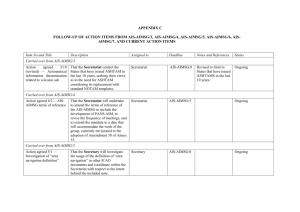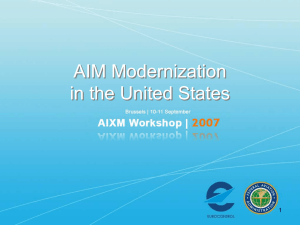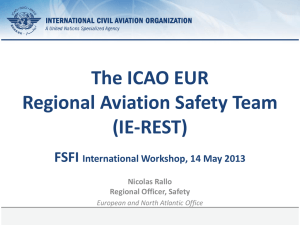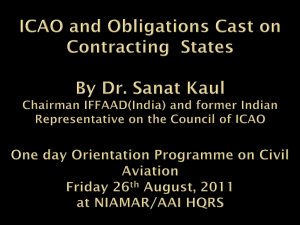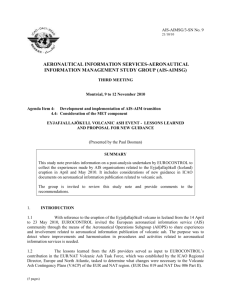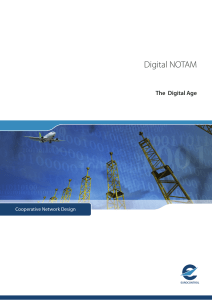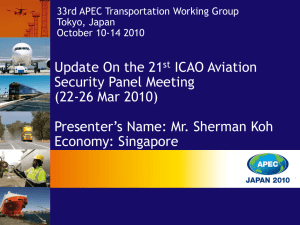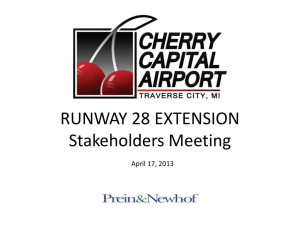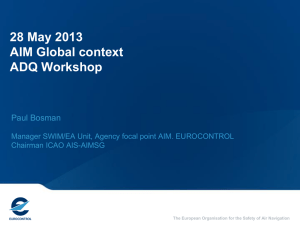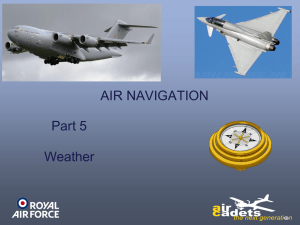RSC Reporting Automation
advertisement
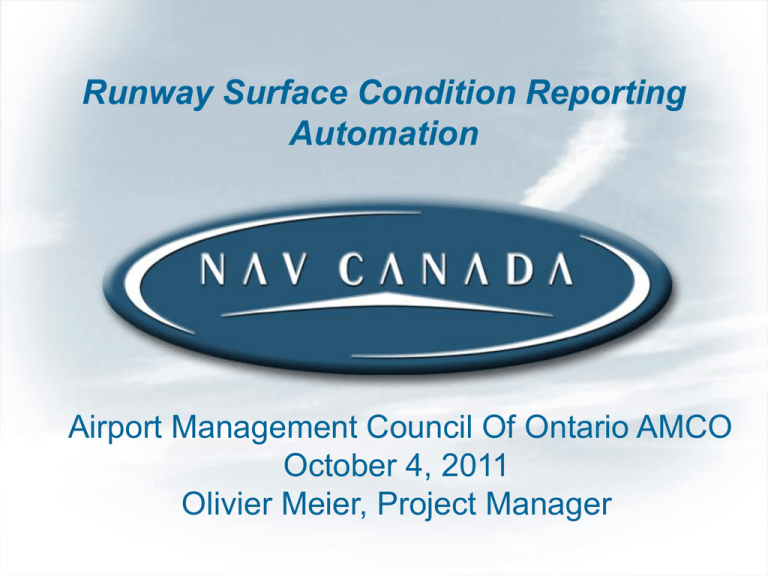
Runway Surface Condition Reporting Automation Airport Management Council Of Ontario AMCO October 4, 2011 Olivier Meier, Project Manager We don’t want to see this again What are we doing today? Paper based Process handling Messages FIC/FSS PAPER AMSCR Consequences - RSC Messages land in a stack - Manual input into NAV CANADA systems - Possibility of errors - Delay in transmitting the message What do we want? End to End Digital Data Chain • Ensure that the publication of all data, from Measurement to Dissemination, is efficient and has integrity. Key Issues • Message versus Data • Manual input versus Electronic input • Analogue transmission versus digital transmission How do we address these issues? Message versus Data Its NOTAMJ versus SNOWTAM • NOTAMJ in concept “Not really a NOTAM” but it is distributed and used in the pre flight briefing like a NOTAM • NOTAMJ is not stored in a database but in a repository • NOTAMJ is like a free text message • NOTAMJ is not ‘system friendly’ ICAO SNOWTAM Format • Enable Reporting of all Aerodrome Field Conditions in a single Standard Report – – – • Ensure that the information is clear, unambiguous, timely, and usable by Operators Worldwide – – – • Runways (initial implementation by full RWY length due to operational restrictions) Taxiways Aprons Ensure that Keywords and Text is standardized Minimize non-ICAO Acronyms Specify Reported Unit of Measurement Alignment between NAV CANADA, EUROCONTROL, and FAA Standards and Practices NOTAMJ versus SNOWTAM Canadian NOTAM Procedure Manual CNPM • Clarification on standard reporting practices • – Allow reporting of all Aerodrome Movement Surfaces not just Runways – By definition ICAO SNOWTAM is valid for a maximum of 24 hours and that now applies to NOTAM J. Effective Oct 2011 • New AMSCR form (available Spring 2012) New AMSCR form (available Spring 2012) • • • • • • • Its an .xls file The structure is similar to the SNOWiz web app for smooth transition. Entries for RSC, CRFI, and data relative to a runway are all aligned. Includes more contaminants and combination of contaminants (e.g. DRY SNOW OVER ICE) Includes fields for cleared runway offset, snow banks, obscured runway lights (ICAO requirement) and taxiways/aprons Uses check boxes which reduces the need for hand written entries Transition Period AMSCR form part 1 AMSCR form part 2 Analogue versus Digital New process is needed • Modeled along the “ICAO AIS to AIM” roadmap: • “…AIS must make the transition from supply of predetermined products to the management of aeronautical information to serve future ATM needs …” ICAO Integrated Process Permanent AIS Data Change Accountable Source Module AIS Change Proposal Charts and Publications Data Originator (Accountable Source) Accept Proposal ADMS Coordination with only one office INO module ICAO translator Note 2 Temporary AIS Data Change NOTAM Wizard Create NOTAM Proposal Note 1 Software to convert ICAO format NOTAM to Domesic format TN AF eg. Airport Manager, Tech. Ops. Coordinator Data Files and Reports Note 3 Distribute ICAO and Domestic Format NOTAM Automatic RSC Reporting Units Runway Surface Condition Report (SNOWTAM) via XML Data Exchange Note 1. The NOTAM Wizard will be integrated into the Accountable Source Module Note 2. Procure International NOTAM Operations (INO) client licenses for the AIS data collections team. Project Work Note 3. Implement interface to AFTN switch for distribution of NOTAM to users in their required format (Canadian or ICAO). What will be new? 3 means of transmission • AMSCR Form • SNOWiz web app • SNOWiz web service SNOWiz Web App Main Milestones • 1st trial with SNOWIZ in Timmins end of Dec 10 • 2nd trial with SNOWIZ in St. Andrew end of Feb 11 • 3rd trial with SNOWIZ in Saint John NB March 11 • General Availability Jan 2012 SNOWiz Web Service • • • For ‘automated’ airports Created an ICD to interface with our system We are in very close collaboration with the two main vendors on the market • Tradewind Scientific: TRACR II • Team Eagle: Winter Ops Pro • Development is outsourced and all dates are depended on the final delivery of the SW for end of Nov 2011. Milestones with Tradewind Scientific • Operational Feasibility Demonstration (OFD) in Toronto Oct 26 2011 • end to end message transfer with live data on the operational systems • Targeting a life trial with Toronto during 20112012 winter season • General availability for all other airports winter season 2012-2013 Milestones with Team Eagle • Planned operational Feasibility Demonstration (OFD) in Winnipeg Nov 2012 • end to end message transfer with live data on the operational systems • Planned go life with full system in Winnipeg Feb 2012 • General availability for every interested Airport Winter season 2012-2013 Key Changes to Canadian Operations that are deferred Reporting by Runway Thirds – ICAO permits reporting by Runway Thirds – This requirement is supported by Operators – The new format will support this but not mandate to allow an orderly transition – The new format will require clear identification when reporting information in Runway Thirds versus report Runway averaged over the entire surface Next steps 28.11.11 26.10.11 First end to end message transfer with live data on the operational systems (OFD Toronto/Winnipeg) Delivery of final SNOWiz software release SNOWiz Web App available to all non automated airports SNOWiz Web Service available to automated airports in respect to their vendors roadmap TIME Jan 2012 Fall 2012 Further Communication • All airports will be addressed directly with a pamphlet explaining how you can get access to the system and to get the starter kit containing the training material (CBT). • Progress will be reported to interested groups such as AMCO, CAC, RCACC etc.. • Progress information is also available through the vendors. • In any case of questions send me an email: meiero@navcanada.ca Thank you
